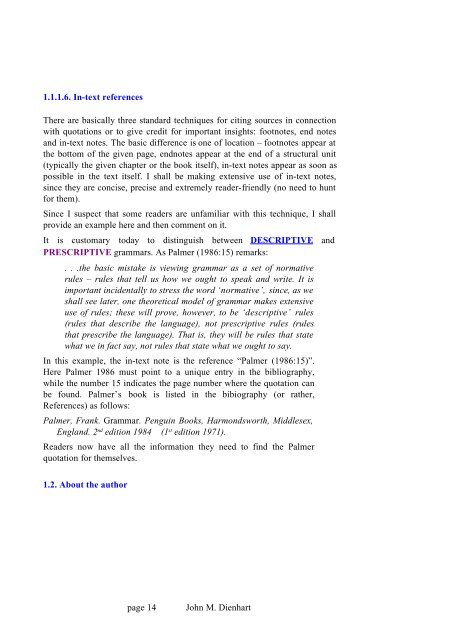Download - VISL
Download - VISL
Download - VISL
You also want an ePaper? Increase the reach of your titles
YUMPU automatically turns print PDFs into web optimized ePapers that Google loves.
1.1.1.6. In-text references<br />
There are basically three standard techniques for citing sources in connection<br />
with quotations or to give credit for important insights: footnotes, end notes<br />
and in-text notes. The basic difference is one of location – footnotes appear at<br />
the bottom of the given page, endnotes appear at the end of a structural unit<br />
(typically the given chapter or the book itself), in-text notes appear as soon as<br />
possible in the text itself. I shall be making extensive use of in-text notes,<br />
since they are concise, precise and extremely reader-friendly (no need to hunt<br />
for them).<br />
Since I suspect that some readers are unfamiliar with this technique, I shall<br />
provide an example here and then comment on it.<br />
It is customary today to distinguish between DESCRIPTIVE and<br />
PRESCRIPTIVE grammars. As Palmer (1986:15) remarks:<br />
. . .the basic mistake is viewing grammar as a set of normative<br />
rules – rules that tell us how we ought to speak and write. It is<br />
important incidentally to stress the word ‘normative’, since, as we<br />
shall see later, one theoretical model of grammar makes extensive<br />
use of rules; these will prove, however, to be ‘descriptive’ rules<br />
(rules that describe the language), not prescriptive rules (rules<br />
that prescribe the language). That is, they will be rules that state<br />
what we in fact say, not rules that state what we ought to say.<br />
In this example, the in-text note is the reference “Palmer (1986:15)”.<br />
Here Palmer 1986 must point to a unique entry in the bibliography,<br />
while the number 15 indicates the page number where the quotation can<br />
be found. Palmer’s book is listed in the bibiography (or rather,<br />
References) as follows:<br />
Palmer, Frank. Grammar. Penguin Books, Harmondsworth, Middlesex,<br />
England. 2 nd edition 1984 (1 st edition 1971).<br />
Readers now have all the information they need to find the Palmer<br />
quotation for themselves.<br />
1.2. About the author<br />
page 14<br />
John M. Dienhart
















